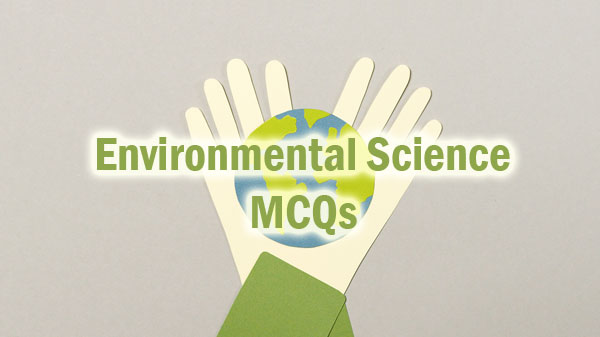Environmental Studies Model Question
Download all Environmental Studies Model Question Papers here. We are providing Environment Science Model Question Papers. We have given the solutions for EVS solved Model Question Papers to make your preparation efficient.

Click here to Download the Environment Science Model Question Papers from the attached pdfs. EVS Model Question Papers attached in the PDF Format so the aspirants can download quickly. Along with these Environmental Studies Model Question papers, we have attached Environment Science Syllabus and Exam Pattern.
Environmental Studies Model Question Papers are available. Applicants can download EVS Model Question Papers. Also, get the Study material, Preparation tips in addition to the EVS Model Question Papers for posts. On our page, we provide Environmental Studies Model Question Papers for the sake of aspirants.
Model Question on Environmental Studies
1. The temperature at Tropical Tropopause (Ht 17 km) is about …………. °C.
(A) –75
(B) –95
(C) –50
(D) –60
2. In a thermodynamic system entropy Ø is defined as …………. where dh is heat added, p and T are pressure and temperature.
(A) dh/p
(B) dh/T
(C) dh/T2
(D) dh/pT
3. In case of temperature inversion:
(A) Lapse rate is positive
(B) Temperature is constant with height
(C) Temperature is not a function of z
(D) Lapse rate is negative
4. Coriolis force is a function of …….
(A) Altitude
(B) Latitude
(C) Longitude
(D) Pressure
5. Warm ocean current flowing from east coast of U.S. towards Europe is known as:
(A) Kurosio current
(B) Benguela current
(C) Gulf stream
(D) Peru current
6. Droughts of All India scale such as 1972 drought are …………. associated with EL Nino events.
(A) Always
(B) Never
(C) Rarely
(D) Sometimes
7. Prevailing wind direction at a station ‘A’ is mostly NE’ly at the height of 10 m. A plume of smoke at that height will drift towards:
(A) North
(B) East
(C) South-West
(D) North-West
8. Evaporation and precipitation over the earth changes with latitude. Evaporation exceeds precipitation in …………. of the Northern hemisphere.
(A) Polar region
(B) Subtropical region
(C) Equatorial region
(D) Latitude region
9. Harmful UV radiation emanating from the sun is prevented from reaching the earth surface by the presence of ozone in the:
(A) Mesosphere
(B) Thermosphere
(C) Stratosphere
(D) Troposphere
10. The greenhouse gases trap the energy reflected:
(A) From the earth and keeps the earth cool
(B) From the earth and keeps the earth warm
(C) On its way from the sun and keeps the earth cool
(D) On its way from the sun and keeps the earth warm
11. Hydro energy is the energy produced from:
(A) Sunlight
(B) Water
(C) Coal
(D) Fossil fuel
12. Which one of the following is the most abundant gas in the stratosphere?
(A) O3
(B) NO2
(C) CO
(D) C6H6
13. What are direct effects of increasing amount of smoke in the atmosphere?
(A) Reduced visibility
(B) Poor air quality
(C) Formation of acid rain
(D) All of the above
14. Which one of the following is a secondary pollutant?
(A) SO2
(B) O3
(C) CO
(D) NO
15. Solar energy can be converted directly into electric energy with the help of:
(A) Photovoltaic cell
(B) Dry cell
(C) Rechargeable cell
(D) Photothermal device
16. Which one of the following does not contribute significantly to global warming?
(A) NO
(B) O3
(C) SF6
(D) HFCs
17. Scintillation counter is used mainly for the determination of:
(A) α-particles
(B) β-particles
(C) ȣ-particles
(D) β and ȣ-particles only
18. Which clay mineral has hydrogen bond?
(A) Kaolinite
(B) Vermiculite
(C) Beidelite
(D) Montniorillonite
19. The chemical formula of Talc mineral is:
(A) CaF2
(B) CaSO4.2H2O
(C) MgSi4O10 (OH)2
(D) SiO2
20. Mass spectrometers are used to determine:
(A) Bulk properties of sample
(B) Relative mass of atoms
(C) Acidity of the sample
(D) Absorption of light
More Questions on Environmental Science
21. Permanent hardness of water is caused due to:
(A) Magnesium sulphate
(B) Magnesium carbonate
(C) Magnesium bicarbonate
(D) Sodium chloride
22. In the COD test of sewage, organic matter is oxidized by K2Cr2O7 in the presence of:
(A) HCl
(B) H2SO4
(C) HNO3
(D) HF
23. Rate of water percolation is the lowest in:
(A) Sandy soil
(B) Clayey soil
(C) Alluvial soil
(D) Desert soil
24. Photomultiplier Tube (PMT) detector is used in:
(A) Ion chromatograph
(B) Gas chromatograph
(C) Atomic absorption spectrometer
(D) TOC analyzer
25. Which one of the following is not a nitrogenous fertilizer?
(A) Urea
(B) DAP
(C) Ammonium sulphate
(D) Superphosphate
26. Which one of the following is not a micronutrient for plants?
(A) Zn
(B) Cu
(C) Mn
(D) S
27. Empirical formula CH2O will give the following compound for four number of its empirical formula ………….
(A) C4H16O4
(B) C4H8O4
(C) C4H6O6
(D) C4H10O8
28. How many moles of iron are there in 122 of Fe? (MW of iron is 55.858)
(A) 1.28 mol Fe
(B) 1.18 mol Fe
(C) 2.18 mol Fe
(D) 8.12 mol Fe
29. The mass of an ice cube having each side of 3.0 cm and density 0.92 g/cm3 will be:
(A) 28.4 g
(B) 84.28
(C) 42.8
(D) 24.88
30. Which of the following is not a flexible mechanism under the Kyoto Protocol?
(A) Joint implementation
(B) Carbon trading
(C) Clean development mechanism
(D) Emissions trading
31. The number of electrons in Fe++ is:
(A) 26
(B) 24
(C) 18
(D) 16
32. Facultative ponds method used for treatment of organic waste involves:
(A) Aerobic process
(B) Anaerobic process
(C) Aerobic and anaerobic process
(D) All of the above
33. Conversion of organic nitrogen into inorganic nitrates which plant can take up is known as:
(A) Ammonification
(B) Denitrification
(C) Nitrification
(D) Deeutrophication
34. A progressive accumulation of toxic substances through food-chain result into:
(A) Bioaugmentation
(B) Biostimulation
(C) Biofiltration
(D) Biomagnification
35. There is a relationship of D.O. and free CO2 in water, which one of the following is correct?
(A) Higher D.O. and high free CO2
(B) Lower free CO2 and low D.O.
(C) Both D.O. and free CO2 equal
(D) Low D.O. and high free CO2
36. Plant species which have developed special adaptation such as pneumatophores for respiration are seen in:
(A) Mangrove ecosystem
(B) Lotic ecosystem
(C) Lake ecosystem
(D) Desert ecosystem
37. One of the major criteria used in identification of biodiversity ‘Hot spot’ is:
(A) Rare species
(B) Endemic species
(C) Area covered by vegetation
(D) Area with economical species
38. In India higher endemic species are reported from:
(A) Desert
(B) Western Ghats
(C) Cold Himalayan region
(D) Runn of Kutch
39. Fuel Bio-gas is predominantly:
(A) Hydrogen
(B) Carbon monoxide
(C) Ethane
(D) Methane
40. In potable water analysis Escherichia coli is used as indicator because E. coli is:
(A) Enteropathogen
(B) Opportunistic pathogen
(C) Common inhabitant of human intestine
(D) Easily cultured and detected
41. Which of these bacteria do not produce insecticidal proteins?
(A) Bacillus spherices
(B) Paenibacillus popilae
(C) Bacillus thuringiensis
(D) Bacillus stearothermophilus
42. Green India Mission is a part of:
(A) Millennium Development Goals
(B) National Action Plan for Climate Change
(C) River Action Plan
(D) Swatch Bharat Abhiyan
43. Influenza, measles and mumps are ……………… borne infections.
(A) Air
(B) Water
(C) Soil
(D) Food
44. Electrical output of a solar cell depends on:
(A) Intensity of solar radiation
(B) Heat component of solar radiation
(C) UV component of solar radiation
(D) MIR component of solar radiation
45. Nuclear fusion requires high temperature because:
(A) All nuclear reactions absorb energy
(B) The binding energy must be supplied from an external source
(C) The mass defect must be supplied
(D) All nuclear reaction release energy
46. Series of waves that propagate at high speeds, travel great distances, which occurs when a body of water such as an ocean gets rapidly displaced is termed as ……….
(A) Storm
(B) Tsunami
(C) Flood
(D) Hurricane
47. A ……………. is an equatorial orbit of satellite at approximately 36000 km altitude, which completes one orbit around the earth in the same time needed for earth to rotate about its axis.
(A) Sunsynchronous orbit
(B) Geostationary orbit
(C) Low earth orbit
(D) Elliptical orbit
48. ……………….. are basic and still widely used form of Remote Sensing.
(A) Radar data
(B) MSS data
(C) Aerial photographs
(D) Hyperspectral data
49. Remote sensing techniques make use of properties of ……………… emitted, reflected or diffracted by sensed objects.
(A) Electric waves
(B) Sound waves
(C) Electromagnetic waves
(D) Wind waves
50. Baseline data in EIA describes:
(A) Cost Benefit analysis
(B) Assessment of risk
(C) Environmental consequences
(D) Existing environmental status of the identified study area

